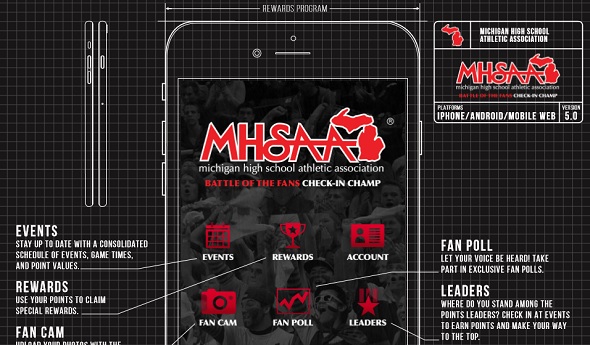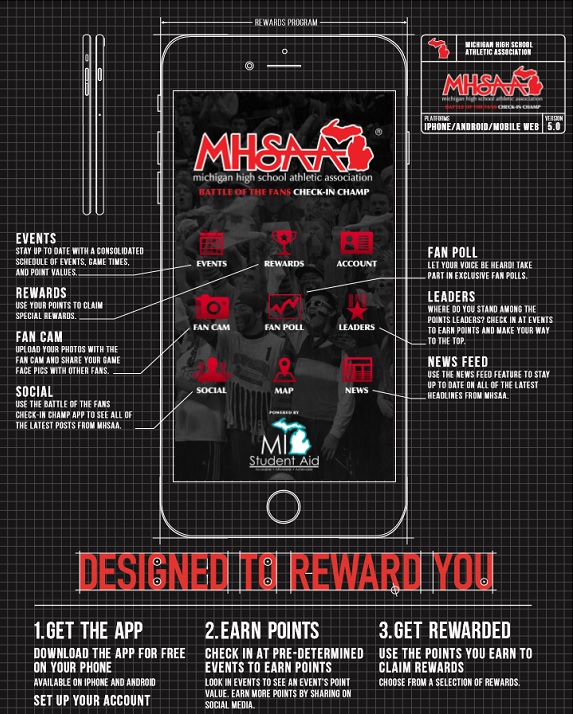
'Check-in Champ' App Rewards Fans
January 10, 2017
By Geoff Kimmerly
Second Half editor
The Michigan High School Athletic Association and SuperFanHigh, a leading fan loyalty and engagement company, have launched a mobile app that will allow students, faculty, alumni, community members and all fans to earn prizes and college scholarships by showing support for high school basketball teams.
To participate, fans simply need to download the “Check-in Champ” app for free from the Apple iTunes or Google Play online stores and then check in at high school girls and boys basketball games they are attending this season. SuperFanHigh will track these check-ins and provide standings of fans who attend the most events statewide beginning Tuesday, Jan. 10. Fans “checking in” accrue points toward prizes including a total of $5,000 in college scholarships sponsored by MI Student Aid.
“The ‘Check-in Champ’ contest provides an exciting opportunity for our schools to promote their regular-season girls and boys basketball games,” MHSAA Executive Director John E. “Jack” Roberts said. “We’re eager to see how this will build more excitement at games, both during the regular season and the MHSAA tournament, and we’re appreciative of MI Student Aid for adding significant incentive for students and their families who support their classmates and communities.”
For the remainder of this Michigan high school boys and girls basketball season, fans who attend games will earn points. When registering on the app, fans must select their favorite school. Schools will be divided by Class: A, B, C and D. A $3,000 scholarship will be awarded to the fan who earns the most points overall across all four classes, and $500 scholarships will be awarded to fans who earn the most points in each class.
Only student fans will be eligible to use the college scholarships; however, fans who are not students may still compete for the scholarships and designate them for specific students should they win the contest. All fans, including those who are not students, will be able to earn app “badges” as they accrue points, and the top 100 point-getters will receive shirts printed to celebrate their accomplishment in the contest.
“We are excited about partnering with the MHSAA to launch this new app,” said Anne Wohlfert, Director of the Student Financial Services Bureau at the Michigan Department of Treasury. “We are pleased to offer $5,000 in scholarship dollars to the students who attend the most games. This joint venture aligns with our goals to provide high school students and their families with student financial resources and information.”
The app provides other information for students and fans including their selected schools’ boys and girls basketball team schedules, MHSAA news and an opportunity to share photos through a ‘fan cam.’ Participants may accrue bonus points by answering MHSAA basketball trivia questions and promoting their “check-ins” on social media.
SuperFanHigh is a division of its parent company, SuperFanU and provides fan experiences for more than 300 high schools and colleges/universities across the country. The company is leading the market in developing innovative platforms that allow the communication and marketing between students/fans and schools to be more engaging and efficient.
“We know that our partnership with MHSAA will yield lots of excitement this year across the state of Michigan,” says Kayla Mount, co-founder and COO of SuperFanU.


From the Director: Back to School
August 7, 2020
By Mark Uyl
MHSAA Executive Director
Since March 12, our world has been anything but normal. These times have tested most everything in life, and as summer turns toward fall, we find ourselves still with far more questions than answers. It has been said that an abnormal reaction to an abnormal situation is normal behavior.
Let me start with these abnormal times. I’ve had many conversations with administrators over the past month about the start of school and school sports. The one constant theme is these are anything but normal times. Many of these conversations have moved to the issue of schools starting the academic year virtually while considering whether or not to offer school sports opportunities this fall. Let me share the things that have been part of almost all conversations on this topic.
The loudest message I hear is kids are going to be playing sports this fall someplace. Period. If we believe that kids are going to take the fall off if school sports aren’t offered, we haven’t been paying much attention since May. Since that time, athletic activity has taken place in the club, travel, AAU and non-school space nearly every day. From first-hand experience, many of these events have implemented ZERO of the safety standards and protocols that businesses and schools have adopted for their plans of return. The non-school world generally has plowed ahead this summer with few-to-no rules, regulations, enforcement, oversight and accountability to anyone. If kids are going to be playing sports, our member schools are telling us that activity needs to be in the safest environment possible – which is with professional educators and trained coaches in our school sports world.
Schools are quick to point out that kids have been conditioning and training with school coaches in school-sponsored workouts most of the summer. We believe that the absence of virus outbreaks among our 749 high schools’ summer activities, involving thousands of kids, has been because schools have been following the return-to-activity plans. Districts have told us they can continue doing what they’ve been doing safely since June by following all COVID guidance and regulations we have put in place with government’s leadership and partnership.
Schools starting the year virtually are telling us they will use the lessons learned from the start of sports for when students return to campus later in the fall. School administrators have shared this view privately as this has become a highly-charged topic among various groups within our school communities. Sports allow schools to bring students back to campus in small, consistent and defined groups with the same adults working with those students each day. In school sports, there is little mixing of students from one sport with those students in another – making it much easier to monitor, track and trace kids when needed than if all students were in the buildings, hallways and classrooms all day. We hear from administrators that valuable lessons can be learned with athletics in August and September for a successful school start-up with students back on campus in October.
All of us share the fundamental belief that we must protect the health and safety of individuals first. This doesn’t include only COVID prevention measures, but also the mental health of teenage students and adults as well. In districts that are starting the school year online, they see athletics being the one shred of normalcy students, and staff members who choose to coach, will have during the fall. It’s a chance to safely interact with peers and get needed physical activity that hasn’t been happening for some kids since March. Health and safety has to include all facets of the individual, and more research is being shared each day about how mental health is becoming a critical issue. For many at-risk kids, sports is the one motivating factor to keep them in school and progressing toward graduation. Given the challenges of all online education for these at-risk kids, sports and the daily routine they bring perhaps would be more important for this group of students than ever before.
With no school sports, the affluent communities and families can navigate online learning during the day and then afford the non-school athletic opportunities that kids and families in less-affluent areas simply cannot. In many communities, school sports can provide opportunities and open doors that would not appear if kids become priced-out from participating and competing.
The past five months have been the most abnormal in a century. School sports being the one pathway back to school for students in our state – the one norm for this fall – run by professional educators who put kids first, would be an incredible boost to the physical and mental health of all of us. We believe that school sports can be done safely and smartly, and the MHSAA has developed plans that do just that. While the optics of sports taking place while waiting for in-person education is not what any of us prefer, we believe we must react to these abnormal times by thinking differently and looking at these unique times through a unique lens.
Trying to find one normal for our kids in these abnormal school days might just be the best thing we can do.

